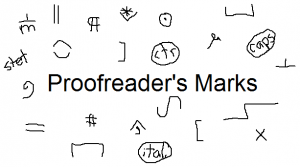Yes, I should have proofread this blog post before publishing it, but you know how thyme gets away from you. It’s possible there may be errirs I didn’t catch.
 Proofreading is impotent because readers get annoyed when they see mistakes left behind. They may conclude you’re not a competent writer. Worse, depending on the mistakes you make, you can convey a meaning counter to what you mint.
Proofreading is impotent because readers get annoyed when they see mistakes left behind. They may conclude you’re not a competent writer. Worse, depending on the mistakes you make, you can convey a meaning counter to what you mint.
I’ve blogged about editing once or twice before, and I may have been lumping proofreading inn with that term. There is a distinction. In fact, in large publishing houses, there are different people involved; the editor and the proofreader halve different skills.
Editing should precede proofreading, and it concentrates on the biggger picture. An editor is checking for focus, readability, clarity, logic, good transitions, and consistent tone.
A proofreader, by contrast, is checking for speling errors, the bad affect of grammatical errors, use verb tense problems, words that might missing, mis$ing or incorrect punctu@tion, and poor sentence structure such as run-on sentences or sentence fragments that.
How do you go about proofreading? There’s some excellent advice available here, here, here, and here. I’ll repeat some of that advice below, grouped into categories:
Spelling
- Don’t trust spell checkers. Use them, but realize they only check four spelling, knot the correct use of a word.
- Keep a dictionary on hand. This helps with obscure words that spell-checkers don’t no.
- Read backward. An old trick, but it werks! You’l spot errors more eesily.
References
- Keep reference materials on hand. The web can work for most things, but not all.
- Double-check facts, figures, and proper names. Making sure of these things now can save embarrassment later. Ensure you check “internal facts” such as consistency with your character names, ages, hair and eye color, etc.
Freshness
- Give yourself a break. Keep yourself mentally fresh and alert. Proofreading requires attention to detail.
- Give the manuscript a break. This means to let your creation sit for a time (days, weeks, even months) before proofreading, to make it seem fresh to you. It’s easier to spot errors that way.
Other Proofreading Tricks
- Adopt a critical mindset. Think like an auditor, or channel your most frustrating English teacher from school. Assume your manuscript is awash in errors and you’re going to find them.
- Print out the text, review the hard copy. This works for some people.
- Create a customized proofreading list of your most common errors. I highly recommend this. Keep the list dynamic by adding new errors you uncover.
- Proofread for one category of error, or one type of problem, at a time.
- Read the text aloud. Sometimes errors are easier to spot when spoken.
- Ask someone else to proofread your manuscript. Ideally this would be a fellow writer, or a friend who knows English well and is willing to give you honest criticism.
Its my sincere hope you take more time proofreading you’re stories than I’ve done with this blog post. Eye was a bit rushed today:; but that’s really no excuse?! Starting with the next post, I’ll return two the polished, error-free, grammatically perfect prose you’ve come to expect from—
Pose-sigh-dunce Scribe
